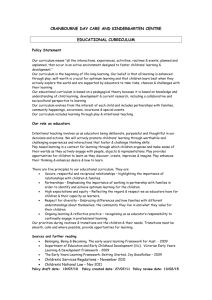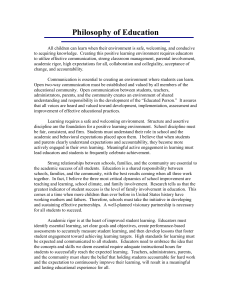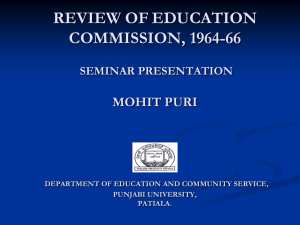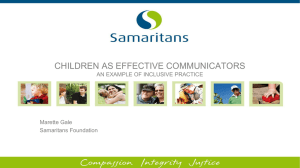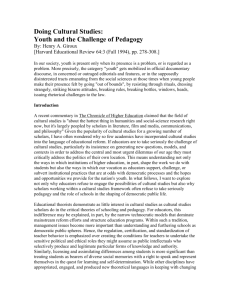Curriculum & Pedagogy Policy - Templestowe Early Learning Centre
advertisement
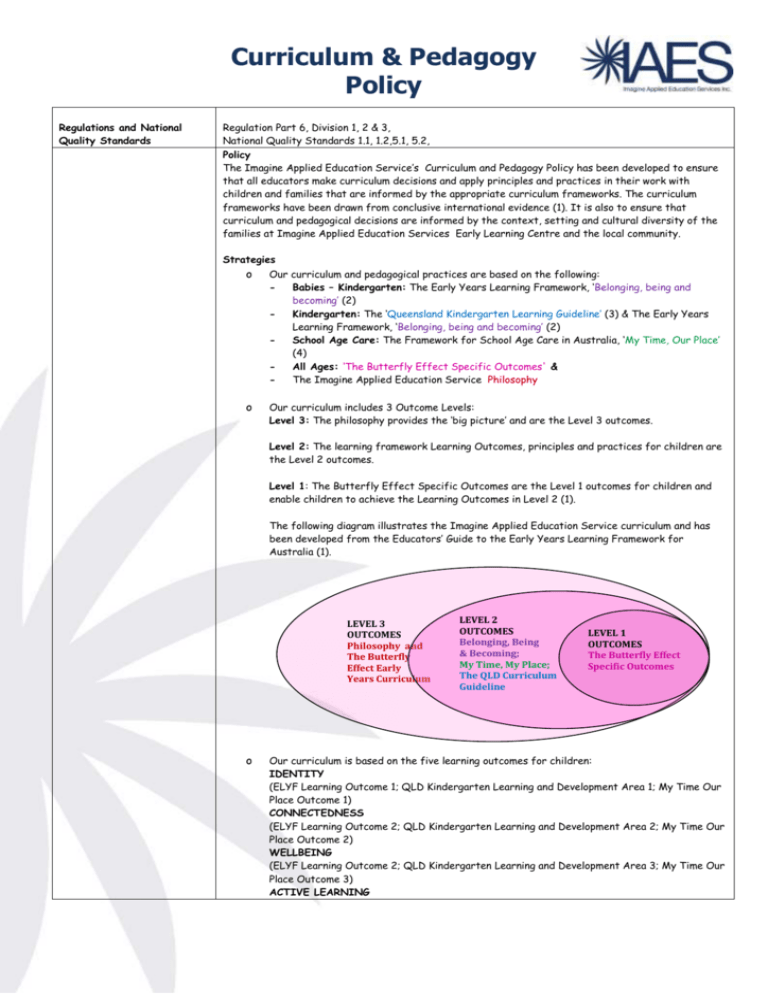
Curriculum & Pedagogy Policy Regulations and National Quality Standards Regulation Part 6, Division 1, 2 & 3, National Quality Standards 1.1, 1.2,5.1, 5.2, Policy The Imagine Applied Education Service’s Curriculum and Pedagogy Policy has been developed to ensure that all educators make curriculum decisions and apply principles and practices in their work with children and families that are informed by the appropriate curriculum frameworks. The curriculum frameworks have been drawn from conclusive international evidence (1). It is also to ensure that curriculum and pedagogical decisions are informed by the context, setting and cultural diversity of the families at Imagine Applied Education Services Early Learning Centre and the local community. Strategies o Our curriculum and pedagogical practices are based on the following: Babies – Kindergarten: The Early Years Learning Framework, ‘Belonging, being and becoming’ (2) Kindergarten: The ‘Queensland Kindergarten Learning Guideline’ (3) & The Early Years Learning Framework, ‘Belonging, being and becoming’ (2) School Age Care: The Framework for School Age Care in Australia, ‘My Time, Our Place’ (4) All Ages: ‘The Butterfly Effect Specific Outcomes' & The Imagine Applied Education Service Philosophy o Our curriculum includes 3 Outcome Levels: Level 3: The philosophy provides the ‘big picture’ and are the Level 3 outcomes. Level 2: The learning framework Learning Outcomes, principles and practices for children are the Level 2 outcomes. Level 1: The Butterfly Effect Specific Outcomes are the Level 1 outcomes for children and enable children to achieve the Learning Outcomes in Level 2 (1). The following diagram illustrates the Imagine Applied Education Service curriculum and has been developed from the Educators’ Guide to the Early Years Learning Framework for Australia (1). LEVEL 3 OUTCOMES Philosophy and The Butterfly Effect Early Years Curriculum o LEVEL 2 OUTCOMES Belonging, Being & Becoming; My Time, My Place; The QLD Curriculum Guideline LEVEL 1 OUTCOMES The Butterfly Effect Specific Outcomes Our curriculum is based on the five learning outcomes for children: IDENTITY (ELYF Learning Outcome 1; QLD Kindergarten Learning and Development Area 1; My Time Our Place Outcome 1) CONNECTEDNESS (ELYF Learning Outcome 2; QLD Kindergarten Learning and Development Area 2; My Time Our Place Outcome 2) WELLBEING (ELYF Learning Outcome 2; QLD Kindergarten Learning and Development Area 3; My Time Our Place Outcome 3) ACTIVE LEARNING Curriculum & Pedagogy Policy Supporting Documentation Sourced (ELYF Learning Outcome 4; QLD Kindergarten Learning and Development Area 4; My Time Our Place Outcome 4) COMMUNICATING (ELYF Learning Outcome 5; QLD Kindergarten Learning and Development Area 5; My Time Our Place Outcome 5) o Educators plan experiences and make assessments of the child's learning using The Butterfly Effect Specific Outcomes. These break down each learning outcome in to more discrete skills. They include: - The Butterfly Effect Specific Outcomes 0 – 2 Years - The Butterfly Effect Specific Outcomes 2 – 3 Years - The Butterfly Effect Specific Outcomes 3 – 5 Years - The Butterfly Effect Specific Outcomes 5 – 6 Years o The program includes both child and teacher initiated planning and experiences. o The program is documented and families have access to their child's program o The program for babies is documented in the form of their 'Personal Care and Development Plans' o Educators collaborate and participate in the children’s learning and play. o Educators scaffold children’s learning by consolidating and extending their skills and communication o Educators encourage children’s choices and decision making skills. o Educators include experiences in their programming which foster all of the developmental areas, including: physical fine motor, gross motor, social, emotional, language and communication, and cognitive development. o Educators take into account the child’s strengths, capabilities, culture, interests and experiences when programming experiences for them . o Each child has their very own ‘Child’s Learning Journey’ which is documentation and evidence of their learning. This is sent home twice per year to families to share with them their child’s experiences at the centre. It is available for families to view at any time through arrangement with their child’s Educator. Families are encouraged to give feedback using the 'Educational Practice and Collaboration Form' and meet with their child’s educator’s to discuss their child’s learning and developmental progress o Each child’s learning is assessed through various methods in an ongoing cycle of planning, documenting and evaluating. Children’s assessment of learning informs the program planning. o Educators engage in reflective practice and evaluation of children’s learning and development through conversation with other educators. Educator’s document this reflective practice where possible. Their reflections are used to inform further planning and programming and make improvements to their practices where needed. o Educators identify children who are displaying problems with their learning or development and work collaboratively with the centre, families and community services (if applicable) to work towards helping the child by developing an ‘Inclusion Support Plan’ and following the ‘Inclusion Policy’. o Educators assist children to develop dispositions to regulate their own behaviour and support them to identify their own feelings. Educators will help children who have are displaying behavioural problems by collaborating with families and other educators and developing an ‘Inclusion Support Plan’ for them, and following the 'Behaviour Guidance Policy'. Inclusion Policy Behaviour Guidance Policy Inclusion Support Plan Child's Learning Journey Program The Butterfly Effect Specific Outcomes 0-15 months The Butterfly Effect Specific Outcomes 15 months - 3 years The Butterfly Effect Specific Outcomes 3 - 6 years Personal Care and Development Plan Educational Practice Collaboration Form The Butterfly Effect: Our Early Years Curriculum 1) Commonwealth of Australia, 2010, Educators Belonging, Being & Becoming: Educators’ Guide to the EYLF for Australia, Australian Government Department of Education, Employment & Workplace Relations for the Council of Australian Governments. 2) Commonwealth of Australia, 2009, Belonging, being & becoming: The Early Years Learning Curriculum & Pedagogy Policy 3) 4) Framework for Australia, Australian Government Department of Education, Employment & Workplace Relations for the Council of Australian Governments. The State of Queensland, 2010, Queensland Kindergarten Learning Guideline, Queensland Studies Authority. Commonwealth of Australia, 2011, My Time, Our Place: Framework for School Age Care in Australia, Australian Government Department of Education, Employment & Workplace Relations for the Council of Australian Governments. Reviewed Annually Version 1 (20.5.2013)


